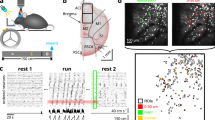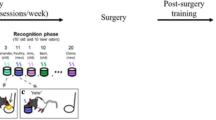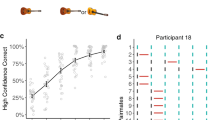Abstract
The hippocampus is important for the acquisition of spatial representations of the environment and consequently in contextual memory. This suggests that the neural substrates underlying spatial cognition might be essential for remembering specific life episodes. Indeed, hippocampal lesions prevent spatial relational learning in adult rodents and monkeys, and result in profound amnesia in adult humans. In contrast, we show here that monkeys with neonatal hippocampal lesions learned new spatial relational information. Our experiments suggest that early hippocampal damage leads to functional brain reorganization that enables spatial information to be acquired through the use of brain regions that normally do not subserve this function.
This is a preview of subscription content, access via your institution
Access options
Subscribe to this journal
Receive 12 print issues and online access
$209.00 per year
only $17.42 per issue
Buy this article
- Purchase on Springer Link
- Instant access to full article PDF
Prices may be subject to local taxes which are calculated during checkout







Similar content being viewed by others
References
Eichenbaum, H. The hippocampus, memory, and place cells: is it spatial memory or a memory space? Neuron 23, 209–226 (1999).
Morris, R.G., Garrud, P., Rawlins, J.N.P. & Okeefe, J. Place navigation is impaired in rats with hippocampal-lesions. Nature 297, 681–683 (1982).
Nadel, L. The hippocampus and space revisited. Hippocampus 1, 221–229 (1991).
O'Keefe, J. & Dostrovsky, J. The hippocampus as a spatial map. Preliminary evidence from unit activity in the freely-moving rat. Brain Res. 34, 171–175 (1971).
O'Keefe, J. & Nadel, L. The Hippocampus as a Cognitive Map (Clarendon Press, Oxford, 1978).
Schenk, F., Grobéty, M.-C., Lavenex, P. & Lipp, H.-P. Dissociation between basic components of spatial memory in rats. in Behavioural Brain Research in Naturalistic and Semi-Naturalistic Settings NATO ASI series, Series D, Behavioural and Social Sciences (eds. Alleva, E., Fasolo, A., Lipp, H.-P., Nadel, L. & Ricceri, L.) 277–300 (Kluwer, Dordrecht, The Netherlands, 1995).
Banta Lavenex, P., Amaral, D.G. & Lavenex, P. Hippocampal lesion prevents spatial relational learning in adult macaque monkeys. J. Neurosci. 26, 4546–4558 (2006).
Astur, R.S., Taylor, L.B., Mamelak, A.N., Philpott, L. & Sutherland, R.J. Humans with hippocampus damage display severe spatial memory impairments in a virtual Morris water task. Behav. Brain Res. 132, 77–84 (2002).
Bohbot, V.D., Iaria, G. & Petrides, M. Hippocampal function and spatial memory: evidence from functional neuroimaging in healthy participants and performance of patients with medial temporal lobe resections. Neuropsychology 18, 418–425 (2004).
Parslow, D.M. et al. Allocentric spatial memory activation of the hippocampal formation measured with fMRI. Neuropsychology 18, 450–461 (2004).
Shelton, A.L. & Gabrieli, J.D.E. Neural correlates of individual differences in spatial learning strategies. Neuropsychology 18, 442–449 (2004).
Nadel, L. & Hardt, O. The spatial brain. Neuropsychology 18, 473–476 (2004).
Lavenex, P. & Banta Lavenex, P. Spatial relational memory in 9-month-old macaque monkeys. Learn. Mem. 13, 84–96 (2006).
Coutureau, E., Galani, R., Jarrard, L.E. & Cassel, J.C. Selective lesions of the entorhinal cortex, the hippocampus, or the fimbria-fornix in rats: a comparison of effects on spontaneous and amphetamine-induced locomotion. Exp. Brain Res. 131, 381–392 (2000).
Whishaw, I.Q. & Jarrard, L.E. Similarities vs. differences in place learning and circadian activity in rats after fimbria-fornix section or ibotenate removal of hippocampal cells. Hippocampus 5, 595–604 (1995).
Rempel-Clower, N.L., Zola, S.M., Squire, L.R. & Amaral, D.G. Three cases of enduring memory impairment after bilateral damage limited to the hippocampal formation. J. Neurosci. 16, 5233–5255 (1996).
Zola-Morgan, S., Squire, L.R. & Amaral, D.G. Human amnesia and the medial temporal region enduring memory impairment following a bilateral lesion limited to field CA1 of the hippocampus. J. Neurosci. 6, 2950–2967 (1986).
Baddeley, A., Vargha-Khadem, F. & Mishkin, M. Preserved recognition in a case of developmental amnesia: implications for the acquisition of semantic memory? J. Cogn. Neurosci. 13, 357–369 (2001).
Gadian, D.G. et al. Developmental amnesia associated with early hypoxic-ischaemic injury. Brain 123, 499–507 (2000).
Vargha-Khadem, F. et al. Differential effects of early hippocampal pathology on episodic and semantic memory. Science 277, 376–380 (1997).
Burgess, N., Maguire, E.A. & O'Keefe, J. The human hippocampus and spatial and episodic memory. Neuron 35, 625–641 (2002).
Moscovitch, M. et al. Functional neuroanatomy of remote episodic, semantic and spatial memory: a unified account based on multiple trace theory. J. Anat. 207, 35–66 (2005).
Rosenbaum, R.S. et al. Remote spatial memory in an amnesic person with extensive bilateral hippocampal lesions. Nat. Neurosci. 3, 1044–1048 (2000).
Teng, E. & Squire, L.R. Memory for places learned long ago is intact after hippocampal damage. Nature 400, 675–677 (1999).
Winocur, G., Moscovitch, M., Caruana, D.A. & Binns, M.A. Retrograde amnesia in rats with lesions to the hippocampus on a test of spatial memory. Neuropsychologia 43, 1580–1590 (2005).
Milner, B., Squire, L.R. & Kandel, E.R. Cognitive neuroscience and the study of memory. Neuron 20, 445–468 (1998).
Moscovitch, M., Nadel, L., Winocur, G., Gilboa, A. & Rosenbaum, R.S. The cognitive neuroscience of remote episodic, semantic and spatial memory. Curr. Opin. Neurobiol. 16, 179–190 (2006).
Duzel, E., Vargha-Khadem, F., Heinze, H.J. & Mishkin, M. Brain activity evidence for recognition without recollection after early hippocampal damage. Proc. Natl. Acad. Sci. USA 98, 8101–8106 (2001).
King, J.A., Burgess, N., Hartley, T., Vargha-Khadem, F. & O'Keefe, J. Human hippocampus and viewpoint dependence in spatial memory. Hippocampus 12, 811–820 (2002).
King, J.A., Trinkler, I., Hartley, T., Vargha-Khadem, F. & Burgess, N. The hippocampal role in spatial memory and the familiarity-recollection distinction: A case study. Neuropsychology 18, 405–417 (2004).
Spiers, H.J., Burgess, N., Hartley, T., Vargha-Khadem, F. & O'Keefe, J. Bilateral hippocampal pathology impairs topographical and episodic memory but not visual pattern matching. Hippocampus 11, 715–725 (2001).
Eichenbaum, H. The hippocampus, memory, and place cells: is it spatial memory of a memory space? Neuron 23, 209–226 (1999).
Squire, L.R., Stark, C.E. & Clark, R.E. The medial temporal lobe. Annu. Rev. Neurosci. 27, 279–306 (2004).
Tulving, E. & Markowitsch, H.J. Episodic and declarative memory: Role of the hippocampus. Hippocampus 8, 198–204 (1998).
Deller, T. & Frotscher, M. Lesion-induced plasticity of central neurons—sprouting of single fibres in the rat hippocampus after unilateral entorhinal cortex lesion. Prog. Neurobiol. 53, 687–727 (1997).
Goldman, P.S. Neuronal plasticity in primate telencephalon anomalous projections induced by prenatal removal of frontal cortex. Science 202, 768–770 (1978).
Steward, O. Lesion-induced synapse reorganization in the hippocampus of cats: sprouting of entorhinal, commisural/associational, and mossy fiber projections after unilateral entorhinal cortex lesions, with comments on the normal organization of these pathways. Hippocampus 2, 247–268 (1992).
Goldman, P.S. & Galkin, T.W. Prenatal removal of frontal association cortex in the fetal rhesus monkey anatomical and functional consequences in postnatal life. Brain Res. 152, 451–486 (1978).
Neville, H.J. The development and neural bases of higher cognitive functions. Ann. NY Acad. Sci. 608, 71–87 (1990).
Villablanca, J.R. & Hovda, D.A. Developmental neuroplasticity in a model of cerebral hemispherectomy and stroke. Neuroscience 95, 625–637 (2000).
Bauman, M.D., Lavenex, P., Mason, W.A., Capitanio, J.P. & Amaral, D.G. The development of mother-infant interactions after neonatal amygdala lesions in rhesus monkeys. J. Neurosci. 24, 711–721 (2004).
Rosset, A., Spadola, L. & Ratib, O. OsiriX: an open-source software for navigating in multidimensional DICOM images. J. Digit. Imaging 17, 205–216 (2004).
Amaral, D.G. & Lavenex, P. Hippocampal neuroanatomy. in The Hippocampus Book (eds. Andersen, P., Morris, R.G.M., Amaral, D.G., Bliss, T. & O'Keefe, J.) 37–114 (Oxford University Press, Oxford, UK, 2006).
Lavenex, P. & Amaral, D.G. Hippocampal-neocortical interaction: a hierarchy of associativity. Hippocampus 10, 420–430 (2000).
Schumann, C.M. et al. The amygdala is enlarged in children, but not adolescents, with autism; the hippocampus is enlarged at all ages. J. Neurosci. 24, 6392–6401 (2004).
Acknowledgements
We thank J. Bennett and P. Tennant for assistance with surgeries and J. Toscano and J. Burky for assistance with behavioral testing. This research was conducted at the California National Primate Research Center (NIH, base grant RR00169) and was supported by grants from the US National Institute of Health (RO1-NS16980, RO1-MH57502), a Faculty and Alumni Research Development Fund grant from the Department of Psychiatry and Behavioral Sciences at the University of California at Davis and a grant from the Swiss National Science Foundation (PP00A-106701).
Author information
Authors and Affiliations
Corresponding author
Ethics declarations
Competing interests
The authors declare no competing financial interests.
Supplementary information
Supplementary Figure 1
Magnetic resonance images showing the medial temporal lobe region of experimental monkeys in three different planes of section (coronal, horizontal and sagittal). (PDF 111 kb)
Supplementary Figure 2
Cdk5 Magnetic resonance images showing the medial temporal lobe region of experimental monkeys in three different planes of section (coronal, horizontal and sagittal). (PDF 111 kb)
Supplementary Table 1
First four choices in the spatial relational condition, individual behaviors. (PDF 513 kb)
Rights and permissions
About this article
Cite this article
Lavenex, P., Lavenex, P. & Amaral, D. Spatial relational learning persists following neonatal hippocampal lesions in macaque monkeys. Nat Neurosci 10, 234–239 (2007). https://doi.org/10.1038/nn1820
Received:
Accepted:
Published:
Issue Date:
DOI: https://doi.org/10.1038/nn1820
This article is cited by
-
Synucleinopathies: common features and hippocampal manifestations
Cellular and Molecular Life Sciences (2017)
-
Functional organization of the medial temporal lobe memory system following neonatal hippocampal lesion in rhesus monkeys
Brain Structure and Function (2017)
-
Non-Human Primates: Model Animals for Developmental Psychopathology
Neuropsychopharmacology (2009)



